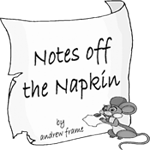 By Andrew Frame
By Andrew Frame
The production order had a grammatically bad note from the salesperson/copywriter at the top: “I picture the character just having a vehicle wrap put on his car and he’s excited by how it looks.” The “character” is a well-known cinema feature, and I fired a warning note back to her supervisor about this little thing called copyright infringement. But, that’s not what this essay is about.
The salesduck had an image in her mind that she could refer to while she wrote. The taglines the character would provide during the script were well-known, and fit perfectly with the image in her head.
The rest of the copy, however, had absolutely nothing to do with the character. Zip. Nada. Nothing. It was an announcer intoning about vehicle advertising wraps. There was no connection between the character and the announcer and the product.
This is a failure to create a frame of reference in your copy for your listeners.
Frame of reference is a construct that you use to communicate one form of information – say, in your head - to another - in this case, advertising copy. You provide enough information to the listener so they can reconstruct what you see in your head – in theirs. If you and the listener are in the same general social strata, they should pick it up almost immediately and effortlessly.
For example, if I start talking about a penguin, Linux users are going to think of Tux, the Linux mascot. Folks thinking of a vacation might think of one of the aquarium-zoo theme parks. A biologist driving to work might think about how leopard seals like to eat penguins.
Each person begins to build their own individual frame of reference based on their life experiences. If I follow the penguin introduction with information about a three-day family pass for half price at Ocean Universe, all three of our listeners – the computer person, the vacation ponderer, and the biologist – will adjust their frame of reference to match mine, now they understand we’re talking about the aquarium-zoo. It happens pretty much as fast as you say the words. (The computer person will also wonder if Ocean Universe uses Linux for their server racks, and the biologist will wonder what Ocean Universe feeds their penguins, but that’s for another essay.)
Here’s another one: I begin a spot with a throaty woman making a happy “mmmmmm” sound. The sound of satisfaction. But, about what? Cars? Sex? Low-fat frozen yogurt?
The next line the listeners hear will take the individual frames of reference beginning in each brain and hopefully bring them to where I want them to be – in line with mine.
The next element in the copy, the first spoken line: “Three days, two nights, room service, and your own private hammock overlooking the warm waters of the Florida Keys.”
Whee! Eating low-fat frozen yogurt during sex in a car -- just landed on a beach! That opening “mmmmmm” is now quickly re-imaging as a happy woman in a hammock in the sunshine. From this point on, I can take the spot wherever I want, because now we’re all sharing the same frame of reference. I can talk about how she’s not stuck in traffic, and she can “mmmmmm” in agreement. When the message closes, she can “mmmmmm” one more time to have the final word. A frame of reference was created using phrasing and conditions our target audience will recognize and can follow for the duration of the sales message.
With our vehicle wrap copy, the salesduck assumed the listener would somehow see the same imagery she had in her head, and pick up on things as they went along. But, there were no cues for the listener to follow.
· There was no setup at the beginning to clue the listener in or directionally tease them.
· There were no script cues – phrases that provided a verbal point to the character’s comments.
· There was no closure to wrap up the message.
There was an announcer, some 1960s styled music, and a character jumping in with his phrases. The character made no reference to his car being wrapped. The announcer made no reference to it either.
Listeners aren’t going to put a lot of psychic wattage into figuring out what the spot is about. You have to tell them, simply and directly. Had the announcer (or character) opened by commenting on how terrific the wrap looked on the car, you would have set the stage. The announcer could comment on the wrap, and the character use a phrase to agree. That call-and-response could be used two or three times – all with the announcer making a comment and the character responding with a catch phrase – and the spot would have been much clearer.
At the beginning, she would have created an immediate frame of reference the listeners would be able to identify, since the character and phrasing are very well known. The next line of copy would have immediately expanded the frame of reference to now include the announcer and the product – all with zero effort on the part of the listener.
This isn’t a problem I run into a lot. But, it does happen, it is preventable, and it can keep a sales message from falling flat.
Happy writing.
♦

